New moons create the most spectacular star trail images by providing the darkest skies possible, allowing for ultra-long exposures (30+ minutes) without moonlight interference. This darkness reveals even faint stars, creating dense, dramatic trails across your night sky compositions. First quarter phases offer a great alternative by providing balanced ambient light for interesting foregrounds while still preserving good star visibility. Each lunar phase reveals different creative possibilities for your nighttime photography arsenal.
New Moon Magic: The Ultimate Star Trail Conditions
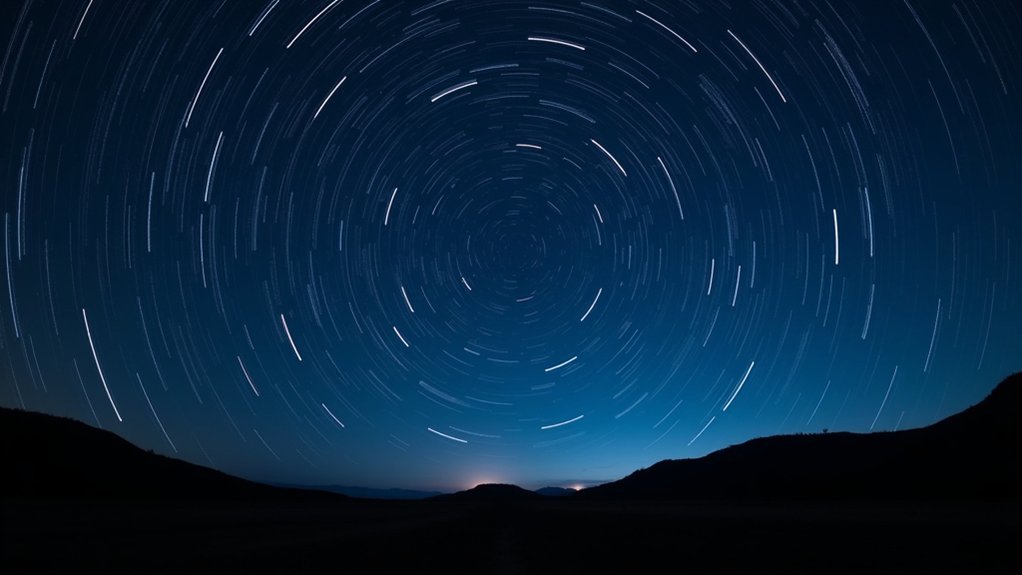
When planning your next star trail photography expedition, nothing beats the pristine darkness of a new moon. This phase offers photographers the ideal conditions to capture breathtaking celestial objects without interference from moonlight.
The absence of moonlight during a new moon creates truly dark skies, allowing you to extend your long exposure times without risking overexposure. You’ll capture well-defined images showing the graceful movement of stars across the night canvas. Even faint stars become visible, adding incredible depth to your compositions.
Since the new moon occurs just once monthly, strategic planning is essential. Mark your calendar and prepare your gear in advance.
The complete darkness during this phase transforms ordinary night shots into extraordinary star trails with vivid details and striking clarity that simply aren’t possible during other lunar phases.
First Quarter: Balancing Moonlight and Star Visibility
The First Quarter Moon offers you an ideal light balance for capturing star trails while still illuminating landscape features.
You’ll need to work within a shorter exposure window, typically using exposures of a few seconds to a couple minutes, as the moon’s brightness (about 1/6th of a Full Moon) provides enough light without washing out the stars.
This phase enhances foreground details naturally, letting you create compositions that showcase both celestial movements and interesting terrestrial elements without requiring extensive post-processing.
Ideal Light Balance
Finding the perfect balance between illuminated landscapes and visible stars often leads photographers to the First Quarter Moon phase. During this time, you’ll enjoy moonlight that’s approximately 1/6th of a full moon’s brightness—creating manageable light conditions that enhance your composition without overwhelming the stars.
The First Quarter Moon’s ideal light balance offers several advantages:
- Ambient light illuminates your landscape while still preserving star visibility in a single frame
- Shorter exposure times become possible for single-exposure star trails, capturing both elements effectively
- Light painting techniques work harmoniously with the natural moonlight for creative foreground enhancement
- Planning shoots 7-10 days after the new moon gives you an excellent window to capture this perfect balance
This sweet spot in lunar illumination creates the foundation for truly epic star trail photography.
Shorter Exposure Window
Beyond just balanced illumination, photographers working during the First Quarter Moon benefit from a distinctly shorter exposure window. You’ll find that exposure times should be limited to 30-60 seconds, preventing star overexposure while still capturing beautiful trails. This manageable illumination creates ideal conditions for experimenting with light painting techniques during your shoot.
| Exposure Element | First Quarter Advantage | Technique Tip |
|---|---|---|
| Star Trails | Visible without washout | Aim for 30-60 second exposures |
| Foreground | Naturally illuminated | Use moonlight as fill light |
| Light Painting | Enhanced visibility | Try subtle movements |
| Night Sky | Balanced contrast | Position moon in composition |
The first quarter’s 50% brightness perfectly balances visibility and contrast, allowing you to incorporate creative movement while maintaining star definition. Use this phase to create compositions where the moon enhances both your foreground and celestial elements.
Foreground Detail Enhancement
While shooting during the First Quarter Moon, you’ll notice an exceptional enhancement of foreground details that’s impossible to achieve during other lunar phases. This perfect balance of moonlight offers approximately 1/6th the brightness of a full moon, creating ideal conditions for star trail photography with distinct landscape elements.
- The moderate illumination allows longer single-exposure star trails with shorter exposure times.
- First quarter moonlight reveals textures in your landscape that remain hidden in darkness during new moon.
- You can combine natural moonlight with light painting techniques for creative composition control.
- The interplay between moonlight and starlight creates dynamic contrast that emphasizes foreground elements.
This lunar phase transforms ordinary landscapes into compelling visual anchors for your star trail photography, giving viewers’ eyes somewhere to rest before traveling upward to the celestial rotations above.
Full Moon Challenges: Working With Bright Night Skies
Although many photographers avoid shooting star trails during a full moon, the bright night sky presents unique opportunities when you understand its limitations. The full moon’s brightness forces you to use shorter exposure times (2-5 minutes) to prevent overexposing the sky, resulting in truncated star trails.
Embrace the full moon’s constraints to discover unique star trail opportunities hidden in the brightness.
You’ll need creative techniques like star stacking to achieve longer trail effects despite these constraints. Focus on incorporating interesting foregrounds to add depth to your night photography—they’ll be beautifully illuminated by the abundant moonlight.
Light painting can further enhance your composition by combining artificial lighting with natural moonlight.
For ideal conditions when capturing dim celestial objects, consider timing your shoot before moonrise or after moonset. This strategic approach helps you balance the challenges of bright night skies while still creating compelling star trail images.
Third Quarter: The Transition Period for Star Trails
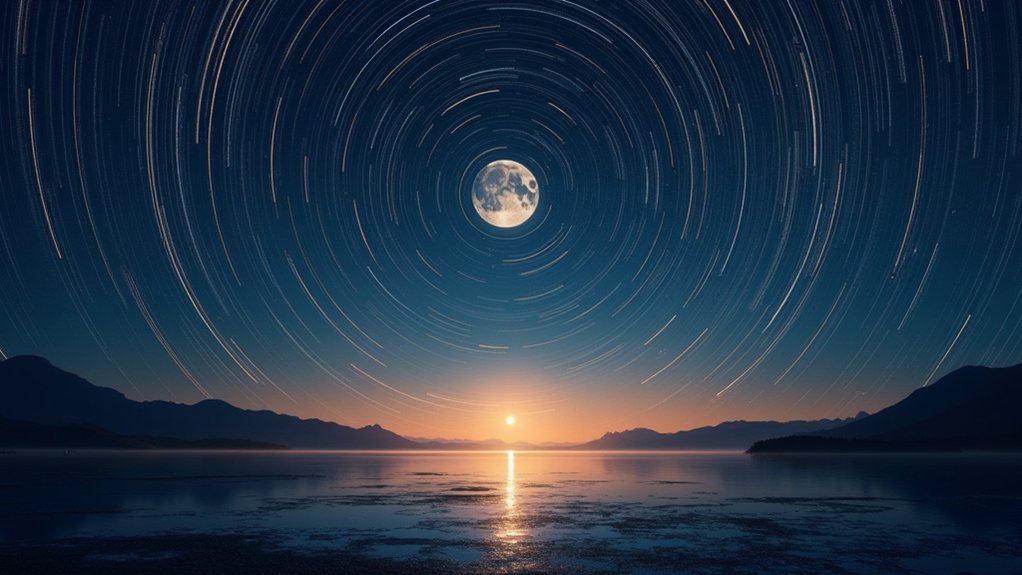
Since it rises around midnight, the Third Quarter Moon offers a strategic advantage for star trail photography that’s often overlooked.
You’ll benefit from moderately dark skies that allow for long exposures without the overwhelming brightness that plagues full moon nights.
This balanced illumination creates perfect conditions for:
- Capturing visible star trails while still having enough light to safely navigate your location
- Experimenting with light painting techniques against the backdrop of developing star trails
- Planning late-night shooting sessions that maximize star trail visibility as the moon sets
- Creating dynamic nightscape compositions during the shift period from Third Quarter to New Moon
As the moon wanes, you’ll find this phase provides the ideal compromise between darkness for stars and ambient light for landscape elements.
Moon Phase Calendar: Planning Your Star Trail Photography Year
Because the moon cycles predictably through its phases every 29.5 days, you can strategically map out your entire year of star trail photography sessions in advance.
Creating a moon phase calendar allows you to maximize each lunar cycle’s unique lighting conditions.
Strategically planning around lunar cycles unlocks the full potential of your astrophotography sessions year-round.
Reserve new moon dates for capturing dramatic Milky Way shots and extended star trails when the sky is darkest.
Schedule first quarter nights for experimenting with light painting techniques while still achieving good star trail results with shorter exposure times.
During full moons, plan compositions that incorporate moonlit landscapes to compensate for reduced star visibility.
Use third quarter periods for versatile night photography that balances moderate darkness with some ambient light.
Equipment Adjustments for Different Moon Phases
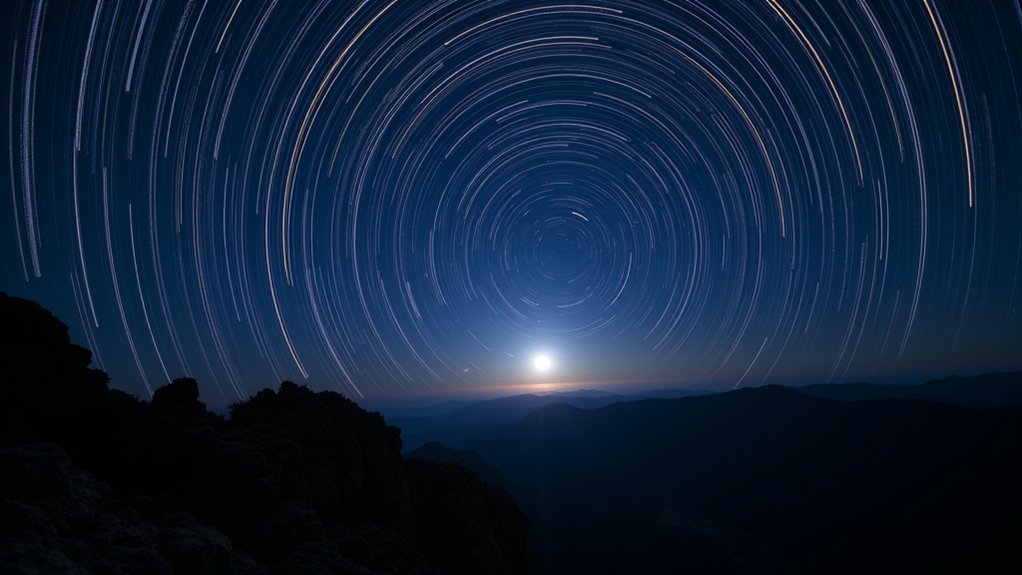
Now that you’ve mapped out your star trail photography calendar, the right equipment setup for each moon phase will dramatically impact your results.
Your approach needs to adapt to the changing ambient light conditions throughout the lunar cycle.
- During a New Moon, maximize those stunning star trails with ultra-long exposures (minutes to hours), keeping your ISO moderate and embracing the darkness.
- For First Quarter and Third Quarter phases, adjust to ISO 400-800 while maintaining longer exposures that produce compelling star trails despite increased ambient light.
- Full Moon nights require shorter exposure times (2-5 minutes) and lower ISO settings (100-400) to prevent washing out your composition.
- Regardless of phase, your essential tools remain constant: a sturdy tripod, remote shutter release or intervalometer, and experimenting with wide angles for dramatic celestial arcs.
Location Scouting: Adapting to Monthly Lunar Cycles
The success of your star trail photography hinges on synchronizing your location choices with the moon’s monthly rhythm. During the new moon, seek dark spots away from city glow for pristine long exposure star trails. This phase occurs every 29.5 days, giving you predictable windows for planning.
For first quarter moon outings, choose locations with interesting foreground subjects that benefit from ambient light. These spots allow for creative light painting while still capturing visible star trails. Use apps like PhotoPills to visualize the moon’s position throughout the lunar cycle relative to your chosen composition.
Scout locations with distinctive landscape elements that can be highlighted differently across moon phases—dramatic silhouettes during new moon or illuminated features during first quarter—maximizing your creative options as the lunar cycle progresses.
Exposure Settings Across the Lunar Month
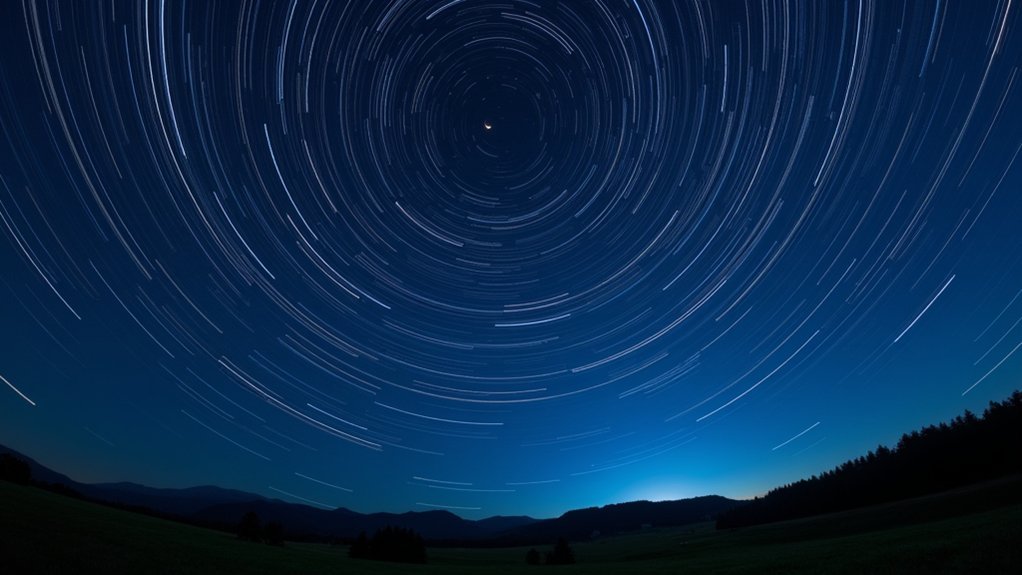
You’ll need to master two distinct approaches when capturing star trails throughout the lunar cycle.
During New Moon periods, embrace the “Dark Sky Magic” by using exposures of several minutes or even hours to record dramatic stellar movement against the blackest canvas nature provides.
As moonlight increases through First Quarter, Full, and Third Quarter phases, you’re engaged in a “Moonlight Balancing Act” where shorter exposures of 30 seconds to 5 minutes will prevent washout while still capturing compelling celestial patterns.
Dark Sky Magic
Understanding how the moon’s phases affect exposure settings can dramatically improve your star trail photography throughout the lunar month. The new moon delivers the darkest skies possible, completely free from moonlight interference—perfect for capturing dramatic star trails and the Milky Way with minimal light pollution.
- During new moon phases, you’ll achieve the longest, most dramatic star trails with exposures of 30+ minutes.
- First quarter moon offers a balance of some moonlight for foreground illumination while still allowing for decent star trail capture.
- Full moon creates bright conditions requiring shorter 2-5 minute exposures, resulting in less dramatic trails.
- Third quarter moon provides moderate darkness, offering a good compromise for both star trails and light painting techniques.
Planning your night photography around specific moon phases guarantees you’ll maximize your photographic opportunities and create truly epic images.
Moonlight Balancing Act
While moonlight adds complexity to night photography, mastering its effects transforms your star trail images throughout the lunar cycle.
New moon phases illuminate the night sky with the darkest skies possible, ideal for lengthy exposures capturing dramatic Milky Way star trails without overexposure concerns.
During first quarter moon, you’ll benefit from moderate illumination, allowing shorter exposure times while still keeping your shutter open long enough for impressive trails and light painting techniques.
Full moon conditions require significant adjustment—limit exposures to 2-5 minutes and incorporate interesting foregrounds to compensate for shorter trails.
As the third quarter moon approaches, diminishing light creates moderate darkness again, perfect for balancing ambient illumination with star movement.
Foreground Elements: How Moon Phases Affect Composition
The moon’s phase dramatically influences how your foreground elements appear in star trail photography. Each phase creates unique opportunities and challenges for balancing your composition between terrestrial subjects and celestial movements.
- New moon offers the darkest skies, making foreground elements appear as silhouettes while maximizing star trail visibility.
- First and third quarter moons provide moderate illumination, perfect for light painting techniques that highlight specific foreground features.
- Full moon bathes landscapes in natural light, requiring shorter exposure times but creating dramatic, well-lit foreground elements.
- Planning around moon phases lets you control the relationship between foreground and night sky, determining whether your composition emphasizes stark contrasts or subtle illumination.
Your choice of moon phase should align with your creative vision for how foreground elements interact with your star trails.
Post-Processing Techniques for Moon-Phase Specific Challenges
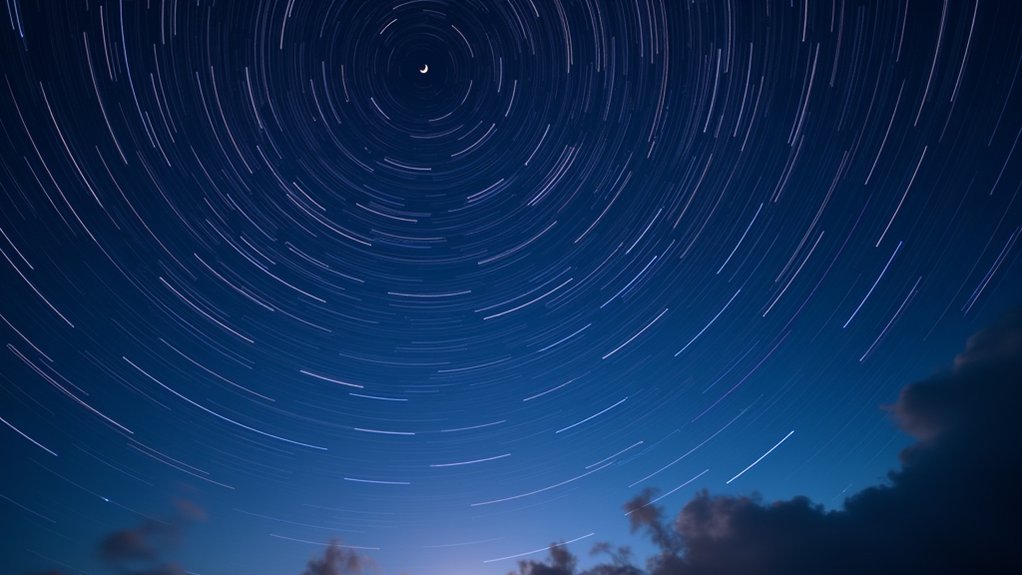
Each moon phase presents unique challenges that require specific post-processing approaches to maximize the quality of your star trail images.
During new moon conditions, you’ll need minimal adjustments as longer exposures capture clearer trails naturally.
New moon nights offer photography’s purest canvas—let your camera drink in the darkness with minimal post-processing intervention.
For full moon photography, stacking shorter exposures (2-5 minutes) helps prevent overexposure while maintaining trail definition.
When shooting during first quarter moon, use Lightroom to manage increased ambient light, then employ StarStaX for effective stacking to preserve star visibility.
Third quarter moon provides an opportunity to combine light painting with moderate exposure lengths, enhancing dynamic lighting in post-processing.
Across all phases, StarStaX’s gap filling and comet mode features prove invaluable for addressing inconsistent lighting challenges, ensuring smooth star trails even when varying moon brightness creates exposure gaps in your sequence.
Frequently Asked Questions
What Is the Best Moon Phase for Star Trails?
You’ll get the most epic star trails during the New Moon phase, when there’s no moonlight to interfere with your long exposures, allowing you to capture longer, more dramatic celestial movements.
What Moon Phase Is Best for Stargazing?
For stargazing, you’ll want to head out during the new moon phase. With no moonlight in the sky, you’ll enjoy the darkest conditions allowing you to see the faintest stars and celestial objects.
What Does Waning Gibbous Moon Phase Mean?
A waning gibbous moon is the phase after a full moon when you’ll see it gradually shrinking from 100% to 50% illumination. It’s still quite bright, lighting up your night sky substantially.
Is the First Quarter Moon Good for Stargazing?
First Quarter Moon offers moderate stargazing conditions. You’ll see bright objects clearly, but fainter stars are less visible. It’s a good compromise—you’ll get celestial viewing while enjoying enough light to navigate the landscape comfortably.
In Summary
You’ll find your best star trail images during the new moon phase, when true darkness releases countless stars. But don’t limit yourself—each lunar phase offers unique creative possibilities. First and third quarters provide subtle moonlight for interesting foregrounds while still revealing stars. Remember to plan with a lunar calendar, adapt your exposure settings accordingly, and you’ll capture stunning star trails regardless of what phase greets you in the night sky.





Leave a Reply